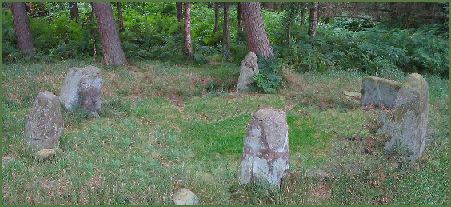Doll Tor Stone Circle
OS Grid ref:- SK238628
 Doll Tor Stone Circle, sometimes referred to as the Six Stones. is situated near to Birchover, west of the upland area of Stanton Moor in the Peak District.
Doll Tor Stone Circle, sometimes referred to as the Six Stones. is situated near to Birchover, west of the upland area of Stanton Moor in the Peak District.
The circle, which stands by a small wood, consists of six standing stones with an adjoining cairn to the eastern side of the circle. The diameter of the circle measures around 6m by 4.5 metres.
The site was excavated in 1852 by the archaeologist Thomas Bateman, who unearthed bucket urns and small cups. It was again excavated from 1931 to 1933 by J. P. Heathcote who discovered five cremations and more urns, the low cairn was found to consist of a central stone grave pit which contained a cremation along with a segmented faience bead, four other cremations had been placed round the inner edge of the stone bank. During the second excavation, three stones were broken and later repaired with cement.
In 1993 the circle was changed by unknown persons to consist of fourteen standing stones with much of the eastern cairn removed. It has recently been restored to how it would have originally appeared in the Bronze Age.
The site is now in the care of English Heritage and the Peak National Park Authority. Stanton Moor is known for its prehistoric monuments and has four Bronze Age stone circles, of which the best known is the Nine Ladies.
Directions
From Bakewell take the A6 and turn right onto the B5056. Take the first left and follow the signs to Stanton-in-Peak. Head South towards Birchover, watching for the Andlestone, a large rock in a field to your right. Park in the lay-by, and cross the gate. Walk to the Andlestone, mpassing it on the left. On arriving at the edge of the field, pass through the gateway and continue to the clump of trees to your left, to the right of the trees is another gate which access to another clump of trees. Pass through the gate, keeping the trees to your left and the wall to your right, and follow the English Heritage sign.
